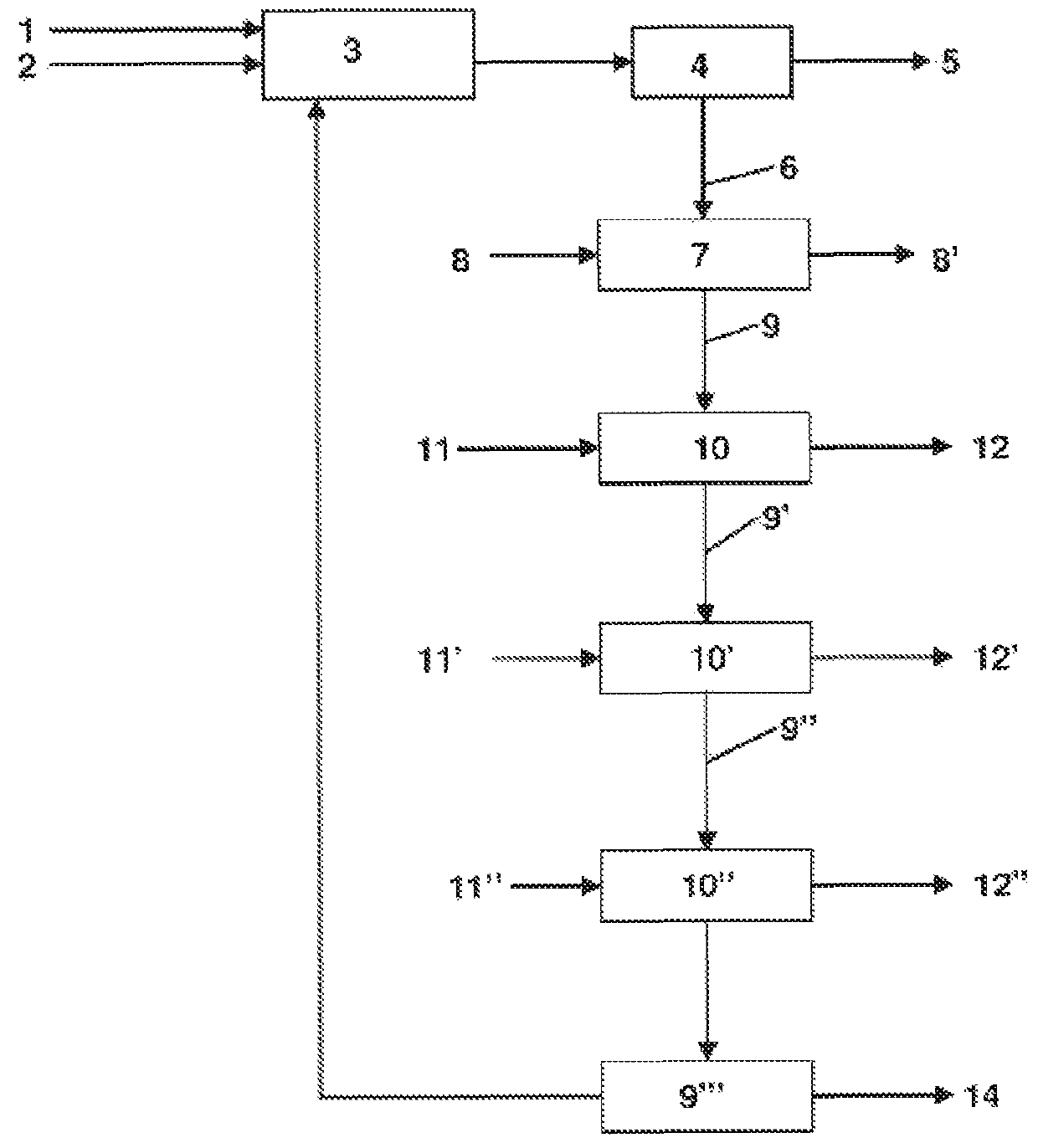Method for recovering ash from waste incineration
a technology of waste incineration and ash, which is applied in the direction of solid waste management, amphoteric ion exchangers, chemical/physical processes, etc., can solve the problems of insufficient sewage sludge purification process, significant increase in waste mass, and inability to add, so as to improve the efficiency of extraction of different elements, reduce the number of steps, and optimize the effect of steps
- Summary
- Abstract
- Description
- Claims
- Application Information
AI Technical Summary
Benefits of technology
Problems solved by technology
Method used
Image
Examples
example 1
[0061]A leaching liquor is prepared, containing a phosphoric acid solution at 20.7% by weight of phosphate ions, from 481.1 g of a phosphoric acid solution at 85% by weight of H3PO4 and 1510.1 g of water. In a digestion reactor, 100 g of ash originating from the incineration of sludge from water purification plants is brought into contact with the phosphoric acid solution at 20.7% by weight of phosphate ions, as prepared above. The ash contains 36.2% of phosphorous (expressed in percentage % by weight in the form of PO4). The ash is digested for 30 minutes at 60° C. The reaction mix is filtered on a filter press. The filtrate is purified by applying 6 cation-exchange resins (Lewatit® S2568H-Lanxess) arranged in series. The aqueous solution of phosphoric acid recovered at the output of the sixth cation-exchange resin contains 98% of the phosphates initially present in the digestion reactor, i.e. of the phosphates initially present in the ash and in the leaching liquor. This phosphori...
example 2
[0064]Example 1 was reproduced using phosphoric acid solutions of different concentrations for digesting the ash. Four phosphoric acid solutions, respectively at 9.9% by weight of phosphate ions, 13.8% by weight of phosphate ions, 27.6% by weight of phosphate ions, and 34.5% by weight of phosphate ions, were prepared using a phosphoric acid solution at 85% by weight of H3PO4.
[0065]
TABLE 2results of the digestion of the ash by phosphoric acid solutionsof different concentrationsweight % inweight % inphosphate ions inphosphate ions inEfficiencyExampleAsh (g)the leaching liquorthe filtrate(%)2A1009.911.1902B10013.815.495.52C10020.722.2982D10027.629.0992E10034.536.698
[0066]As shown by the results summarised in table 2, the phosphate content in the solution obtained after filtration (after step b) of this method) is greater than the phosphate content of the leaching liquor. The phosphorous present in the ash has been extracted and recovered in the form of a phosphoric acid solution. The ...
example 3
[0067]Ash (100 g) mainly containing 18.1% by weight of silicon, 8.7% by weight of aluminium, 15.7% by weight of calcium, 2.3% of iron, 1.5% by weight of magnesium, was treated with 1992 g of a phosphoric acid solution (20.7% by weight of phosphate ions) at 60° C. for 45 minutes. The ash contained less than 1% by weight of phosphorous (expressed in % by weight of PO4). The reaction medium is filtered by a filter press. The liquid phase is purified by the application of 5 ion-exchange resins placed in series (Lewatit® S2568H-Lanxess). A phosphoric acid solution with low contents of metal ions is recovered after this purification. The ion-exchange resins were regenerated with a hydrochloric acid solution at 5% and five aqueous solutions were recovered. The extraction efficiencies for aluminium, calcium, magnesium and iron were respectively 95%, 98%, 98% and 81%.
PUM
| Property | Measurement | Unit |
|---|---|---|
| temperature | aaaaa | aaaaa |
| temperature | aaaaa | aaaaa |
| temperature | aaaaa | aaaaa |
Abstract
Description
Claims
Application Information
 Login to View More
Login to View More - R&D
- Intellectual Property
- Life Sciences
- Materials
- Tech Scout
- Unparalleled Data Quality
- Higher Quality Content
- 60% Fewer Hallucinations
Browse by: Latest US Patents, China's latest patents, Technical Efficacy Thesaurus, Application Domain, Technology Topic, Popular Technical Reports.
© 2025 PatSnap. All rights reserved.Legal|Privacy policy|Modern Slavery Act Transparency Statement|Sitemap|About US| Contact US: help@patsnap.com

